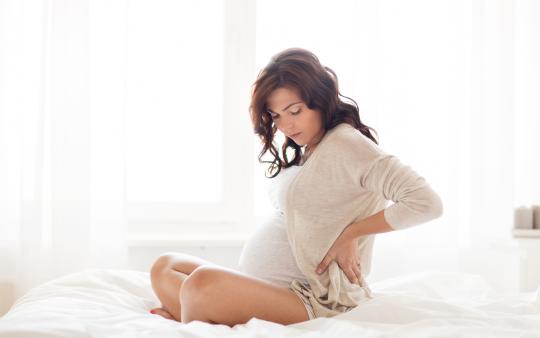“No pain, no gain” should not pertain to pregnancy and how the body changes during gestation. While some level of pelvic awareness and discomfort is normal, all too often pregnant women are told that their intense pelvic region pain is just “part of pregnancy”, is psychogenic, or does not warrant treatment.
Pelvic girdle pain during pregnancy affects approximately one in five individuals. Of the patients who have come to my practice for pelvic pain, their previous providers have given them few to no interventions. Experiencing bodily changes during pregnancy is normal, but the mentality to “white-knuckle” through the often-intense pain and discomfort of pelvic girdle pain should be unacceptable for pregnancy.
Let’s take a closer look at pelvic girdle pain, what it is, and how you can safely and effectively treat it naturally.
What is pelvic girdle pain?
The pelvic girdle anatomically includes the hip bones oriented in a bowl, and connects the pelvic region of the spine, the sacrum, and coccyx, to the lower limbs. Its primary function is to support the body while sitting, transferring weight to the lower limbs in order to stand, and acts as attachment points for muscles, ligaments, and tendons. The pelvic girdle also includes all the anatomical means needed to support the bladder, bowels, and sexual reproductive organs.
Pelvic girdle pain (PGP), also known as symphysis pubis dysfunction (SPD), is the broad term that describes pain in the pelvic region for men and women. Women more commonly experience PGP. Pelvic pain in both men and women can be related to urinary, gastrointestinal, or reproductive issues, as well as trauma or arthritis. Pelvic girdle pain associated with pregnancy, however, is in a league of its own.
Causes of PGP are debated across medical professionals. According to a recent study, "several etiologic factors are proposed in the development of PGP: degenerative, metabolic, genetic, hormonal, and biomechanical factors/non-optimal stability.” The most common causes of PGP are believed to be genetic, hormonal, and mechanical. Some research suggests that there may be an increased genetic risk if your maternal side has experienced PGP, specifically a first-degree relative such as your mother or sister.
Hormonal causes are linked to elevated levels of two pregnancy hormones: relaxin and progesterone. Relaxin, produced by your ovaries and the placenta, makes your ligaments looser in the pelvis in preparation for childbirth. Relaxin also supports the cervix ripening. The increases in tissue laxity, changes in weight and its distribution, as well as changes in body mechanics during pregnancy likely contributes to the mechanical causes of PGP. A history of injury or trauma in the pelvic region can also contribute to PGP.
Pelvic girdle pain in pregnancy
PGP in pregnancy can present as pain in the lower back, hips, pelvis, thighs, or knees. It occurs when the pelvic joints move irregularly. Frequently, the pain is in sacroiliac joints or in the pubic symphysis. PGP can be a dull/aching pain, stiffness, a clicking or grinding when walking, or more intense sharp, shooting pain. PGP can also wax and wane and change in presentation throughout the pregnancy. The most commonly reported symptom in pregnancies with a PGP diagnosis is the feeling of a tearing pain, as if the pelvis is being ripped apart especially when walking, when rolling over in bed, getting in a car, or during sexual intercourse. The pain can be debilitating and cause elevated symptoms of depression and anxiety. PGP is very common during all stages of pregnancy, but is often most intense in the third trimester and can linger post-birth.
Awareness around PGP is not discussed enough in prenatal care, and often comes from peer support groups and friends and family members who have previously experienced it. It is important to report PGP to your obstetrician, midwife, or reproductive team especially if your pain is affecting your day-to-day activities, sleep, or quality of life. If your doctor can not support you, seek a doctor trained in pelvic pain, such as a physiatrist or licensed medical professional trained in techniques such as Mercier Therapy or those by Herman & Wallace Pelvic Rehabilitation Institute.

Pelvic girdle pain relief during pregnancy
As a naturopathic doctor, my recommendations for natural pain relief/treatment for PGP during pregnancy are based on underlying causes and individual needs for ease and affordable interventions.
In general, ways to support the pelvic girdle may include:
- Advocating for early interventions for PGP.
- Evaluating physical, mental, and emotional stress to modulate pain in the body.
- Avoiding obstacles such as heavy lifting and pushing, and heavy weight-bearing exercises if this is not a part of your pre-pregnancy routine.
- Improving body ergonomics when sitting, standing, getting in the car, walking, and optimizing sexual positions during pregnancy.
- Using body pillows in order to keep your pelvis aligned when you rest and sleep.
- Applying a heating pad or ice pack to the pubic bone or slight pressure applied to the pubic symphysis by your partner.
- Avoiding excessive Kegel exercises, as well as straining during bowel movements and urination.
- Discussing natural or pharmacological pain relief options.
- Wearing a pelvic stability belt.
- During labor and delivery, working to reduce hip abduction, minimize the duration of the lithotomy position and promote four position or lateral positions during delivery (Vermani et al., 2009; Kanakaris et al., 2011).
Other recommended interventions may include:
- Referral to a licensed trained pelvic physical therapist for manual therapy.
- Acupuncture for pain relief, trigger point release, and pregnancy support.
- Pregnancy massage starting in the second trimester.
- Stretching and in-home exercises (see below).
- Craniosacral therapy. In a small study, participants in the group receiving craniosacral therapy and prenatal massage reported experiencing lower levels of pelvic pain compared to the group receiving only standard care prenatal massage.
- Water exercises (excluding breast stroke) and therapy.
Exercises for pelvic girdle pain during pregnancy
Some gentle, pregnancy-friendly exercises to help with PGP include the following:
- Bridge: Lying on your back with bent knees, lift your hips up, pushing through your heels and glutes. Hold up for 2-3 seconds, and down for 5 seconds.
- Partial downward dog stretch, supported by a counter or wall.
- Chair pose up against a wall with pelvic tilts.
- Cat stretch, seated on a chair or exercise ball.
- Child's pose side stretch with bolster.
Pelvic girdle pain outside of pregnancy
Pelvic pain outside of pregnancy can present as actual pelvic pain, low back pain, leg pain and postural issues. Urinogenital, gastrointestinal, trauma, or arthritis presentations can also pre-empt pelvic pain.
Other techniques for pelvic pain in non-pregnancy:
- Do not cross your legs when sitting.
- Place a pillow or body pillow between your knees and ankles when lying on your side at night.
- Reduce sit-ups and crunches as they can put excessive pressure on the abdominal cavity and in turn the pelvic anatomy.
- Address underlying pathology.
- See a pelvic physical therapist.
Help is out there
While 20% of all pregnancies can experience PGP, there are treatments and preventative measures that can be used during pregnancy. If you are experiencing or know someone is experiencing pelvic girdle pain, you are not alone and help is out there. Help can come from practitioner, partner support and changes in your daily behaviors.
Resources
Geeta Nagpal, James P. Rathmell. "Managing Pain During Pregnancy and Lactation." Practical Management of Pain, 5th ed. (2014): 474-491.
Gill Brook, Tamsin Brooks, Yvonne Coldron, Ruth Hawkes, Judith Lee, Melanie Lewis, Jacquelyne Todd, Kathleen Vits, Liz Whitney. "Physiotherapy in Women's Health." Tidy's Physiotherapy, 15th ed. (2013): 605-635.
Verstraete, EH et al. “Pelvic Girdle Pain During or After Pregnancy: A Review of Recent Evidence and a Clinical Care Path Proposal.” Facts, Views and Vision in Obstetrics and Gynaecology, vol. 5,1 (2013): 33-43.






